The week at a glance
- White-winged Scoter in Co Kerry
- Thayer's Gull still in Co Galway
- Oriental Turtle Dove still in Oxfordshire
- Pacific Diver still in Cornwall
- American Coot still in Co Mayo
Hot on the heels of a British first came an Irish first this week, in the form of a drake White-winged Scoter at Rossbeigh (Co Kerry) on 7th. This had been reported on and off as a Velvet Scoter since late January, and was picked up by one of the BirdGuides News Team on a weekend trip to the west coast. The large white flash behind the eye, and a bulging base to the reddish-orange bill, were indicative of the species, which was previous considered a race of Velvet Scoter. After BOU split them in 2005, there will be renewed interest in this bird, with no accepted records in Britain or Ireland to date. The only previous claim was a drake off Marske-by-the-Sea (Cleveland) on 26th November 2004. There is also the possibility of further splits in the pipeline, with two distinct races of White-winged Scoter: the American deglandi and the Asian stejnegeri. Although it isn't clear which race this bird belongs to, hopefully better views over the weekend will clear this up.

White-winged Scoter, Rossbeigh, Kerry (Photo: Josh Jones)

White-winged Scoter, Rossbeigh, Kerry (Photo: Davey Farrar)
White-winged Scoter, Rossbeigh, Co Kerry (Film: wrexile1).
There were no definite reports of the Slaty-backed Gull this week, but the first-winter Thayer's Gull was again reported from Rossaveal (Co Galway) on 3rd. Elsewhere, the Oriental Turtle Dove continued to show at times in Chipping Norton (Oxfordshire) to at least 7th. A slight change of viewing arrangements was needed as the novelty had certainly worn off for some residents, but thankfully most birders seem to have followed the 'rules' this week. Other megas still in residence were the Pacific Diver off Penzance and Marazion (Cornwall) all week and the American Coot at Termoncarragh Loch (Co Mayo), though there were no reports of the Co Cork House Crow.
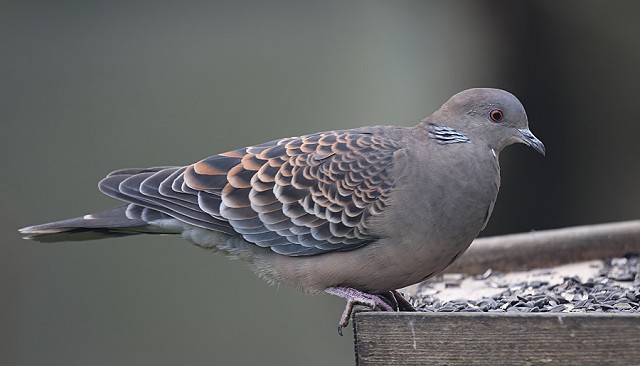
Oriental (Rufous) Turtle Dove, Chipping Norton, Oxfordshire (Photo: Dave Hutton)
There were just two Snow Geese this week, one still at Aghagallon (Co Antrim) on 3rd and another at Strand Loch (Shetland) on 9th. The Ross's Geese also remained at Halvergate Marshes (Norfolk) to 7th, Holme/Titchwell (Norfolk) to 6th and back at Rockcliffe Marsh (Cumbria) on 3rd. The Ferrybridge (Dorset) 'flock' of Black Brants was down to just two this week, present to at least 5th, with others still at Fishbourne (West Sussex) on 3rd and Rosslare (Co Wexford) on 4th. With no reports of feral or colour-ringed Red-breasted Geese, the only bird remaining was on the Channel Islands, at St Aubin (Jersey) on 8th. A few interesting Brantas remained: the Taverner's Canada Goose was still at Ballyconnell (Co Sligo) on 7th, Richardson's Canada Geese were again at Neriby and Loch Gruinart, Islay (Argyll) all week and a possible was at Kelton (Dumfries & Galloway) on 7th.
After a short absence, or lack of observers (unlikely in Norfolk), the female Ferruginous Duck was reported again on Cockshoot Broad (Norfolk) on 8th, with others still present at Oulton Broad (Suffolk) all week and again at Lurgan (Co Armagh) to 3rd.

Ferruginous Duck, Oulton Broad, Suffolk (Photo: Steven Lane)
There were two new drake Ring-necked Ducks reported, at Bispham (Lancashire) from 3rd and Ports (Co Fermanagh) on 5th. Others still in residence were mostly in Ireland, at Lough Cowey (Co Down), Carrowmore Lake (Co Mayo) and Milltown (Co Cavan). The only other was the rather elusive drake at Stithians Reservoir (Cornwall) again on 5th.
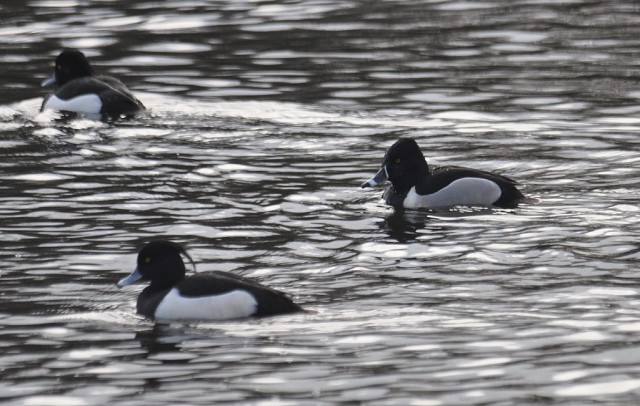
Ring-necked Duck, Bispham, Lancashire (Photo: Jonny Scragg (aged 16))
There were similarly two new Green-winged Teal reported, at Kildrochat (Dumfries & Galloway) on 5th–6th and another at Shapinsay (Orkney). Possibly returning winter birds were at Caerlaverock (Dumfries & Galloway) from 5th and Kinneil Lagoon (Forth) on 3rd. Others also remained at Campfield Marsh (Cumbria) to 3rd and Connaught Water (Essex) all week.
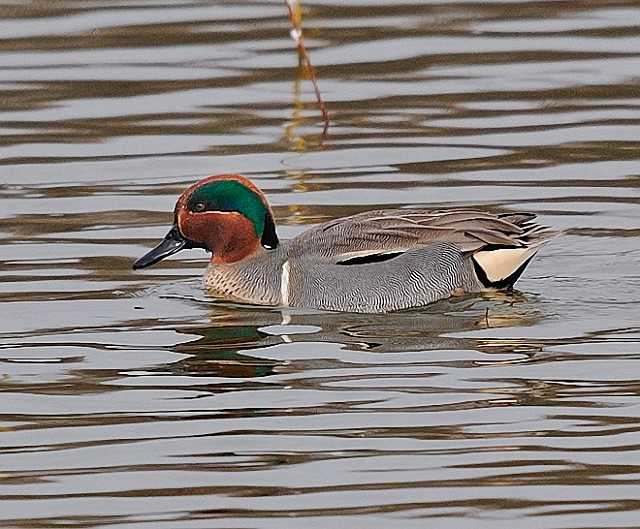
Green-winged Teal, Caerlaverock WWT, Dumfries & Galloway (Photo: Mike Thrower)
After the reappearance of a drake Black Duck in Co Mayo last week, there was another this week, in the harbour at Ventry (Co Kerry) on 4th. The drake American Wigeon remained at Rushy Common (Oxfordshire) to at least 7th and there was also a report of a probable female at Trimley Marshes (Suffolk) on 8th. Apart from a new drake at Lough Sheelin (Co Cavan) on 4th, all other reports of Lesser Scaup were wintering birds, at Slimbridge (Gloucestershire), Dozmary Pool (Cornwall) and both Glamorgan birds (Cosmeston Lakes and Eglwys Nunydd Reservoir).

Lesser Scaup, Slimbridge WWT, Gloucestershire (Photo: Chris Cook)
There seemed to be a bit of a resurgence in Surf Scoters this week, with a real flurry of records. The female was obviously still off Dawlish Warren (Devon) all week and the Co Clare contingent included the drake and female still at Doughmore on 4th and another drake off Black Head on 3rd, with an incredible 57 Black-throated Divers and 100 Great Northern Divers. Back this side of the Irish Sea, the drake was again off Ruddon's Point (Fife) on 5th–6th and two drakes were off Old Colwyn (Conwy) on 6th and nearby Llanddulas the next day. Perhaps in line with the sea-duck revival, the first-winter drake King Eider was again reported from Bluemull Sound (Shetland) on 3rd, in the company of three Northern Eiders. Another possible borealis bird was off Cockenzie and Port Seton (Lothian) on 6th.

King Eider, Bluemull Sound, Shetland (Photo: Brydon Thomason)
Numbers of Smew were also just about on par with last week; birds were present at around 40 sites. There was just one record in Northern Ireland — the redhead still at Quoile Pondage (Co Down) to 6th — none in Wales and five birds at four sites in Scotland, including the redhead still at Loch of Tingwall (Shetland) on 3rd. Elsewhere, peak counts reported were 19 at Paxton Pits (Cambridgeshire) and 14 at both Ravensthorpe Reservoir (Northamptonshire) and Dungeness (Kent). Also of note on the sea were up to 44 Slavonian Grebes off Musselburgh Lagoons (Lothian) on 3rd.

Smew, Dungeness RSPB, Kent (Photo: Martin Till)
There were no shearwaters reported at all during the week, but further signs of spring included Pomarine Skuas past Flamborough Head (East Yorkshire) on 5th and Portland (Dorset) on 6th and a Common Tern past Pendeen (Cornwall) on 9th.
There were reports of Great White Egrets from a round 10 sites this week, including new birds over Ayside (Cumbria) on 7th, at Frampton Marsh (Lincolnshire) on 8th and over Sennen Cove (Cornwall) on the same day. Others were in Lincolnshire, Nottinghamshire, Staffordshire, Norfolk and Kent, and in Somerset up to six remained around Meare Heath. Nearby, the Cattle Egret was again at Shapwick Heath on 8th and others remained on Guernsey and at New Bridge (Devon).

Great White Egret, Meare Heath, Somerset & Bristol (Photo: Jeff Hazell)

Cattle Egret, undisclosed site, Guernsey (Photo: Chris Bale)
Groups of Spoonbills remained at pretty much the same sites as last week and in pretty much the same numbers, peaking at six at Middlebere (Dorset). The only new birds were singletons at Gibraltar Point (Lincolnshire) on 4th, Warleigh Point (Devon) on 6th and Pottington (Devon) on 9th.

Spoonbill, Cley Marshes NWT, Norfolk (Photo: Andy Thompson)
It looks as though some of the wintering Rough-legged Buzzards are moving on, with several long-staying birds not reported this week, including the north Norfolk birds. But reports of birds over Winterton-on-sea (Norfolk), Freiston Shore (Lincolnshire), North Somercotes (Lincolnshire) and one at Kame of Corrigal (Orkney) may relate to birds moving back north. Wintering birds did remain, though, at Hatfield Moors (South Yorkshire) to 3rd, South Ferriby (Lincolnshire) to 8th, Toft (Shetland) to 8th and two at Selset Reservoir (Durham) to 8th.

Rough-legged Buzzard, Selset Reservoir, Durham (Photo: Mark Newsome)
Hampshire's White-tailed Eagle stayed around Old Basing and Newnham all week, and on the Isle of Wight a Golden Eagle at Ventnor Downs was presumably the same bird that has been seen there for the last three years in March/April. When photographed in 2010 it looked to be wearing the remains of jesses, though, giving away its true origin. As with Rough-legged Buzzards, perhaps also now departed are the various Northern Harriers, with no reports this week. Other birds of prey still reported, though, were the possible Tundra Peregrine at Walmsley Sanctuary (Cornwall) to at least 7th and a possible Gyr Falcon on St Martin's (Isle of Scilly) on 8th. The first few Ospreys started to filter through from 7th, with birds over Mellor Brook and Preston (Lancashire) and Bowling Green Marsh (Devon).
For the first time in an age, there was more than one interesting wader to report. The Long-billed Dowitcher remained at Lodmoor (Dorset) to 4th, before moving over to Radipole Lake on 7th–9th, and there was a Grey Phalarope at Spo Ness, Westray (Orkney) on 7th. The first few Little Ringed Plovers also turned up, in Leicestershire, Norfolk, London and West Sussex from 5th.
Of the two big white-winged gulls, Iceland Gulls were reported from twice as many sites as Glaucous Gull: single Glaucous Gulls were at 18 widespread sites, with two at Rossaveal (Co Galway) on 6th. Sites in Cheshire, West Yorkshire, Co Cork, Shetland and on Fair Isle held both species, and there were two Iceland Gulls at Seaton Common (Cleveland) on 8th and three at Richmond Bank (Cheshire) on 3rd. There were again several reports of Kumlien's Gulls, with birds still in Lerwick Harbour (Shetland) to 6th and at Sligo (Co Sligo) to 8th and two new birds on 5th: a third-winter at Enniskillen (Co Fermanagh) and an adult at Chew Valley Lake (Somerset).
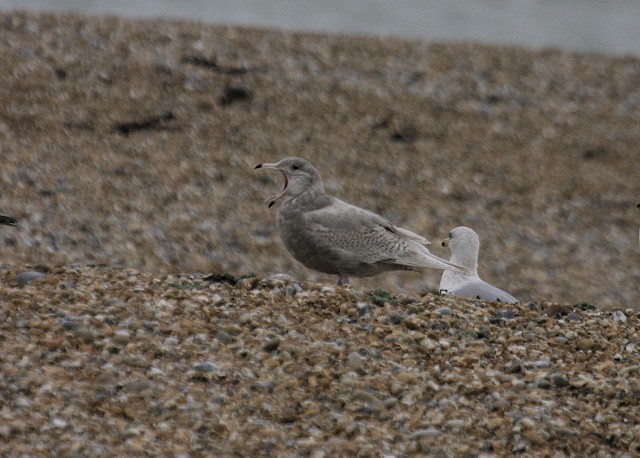
Glaucous Gull, Dungeness BO, Kent (Photo: Chris Bond)
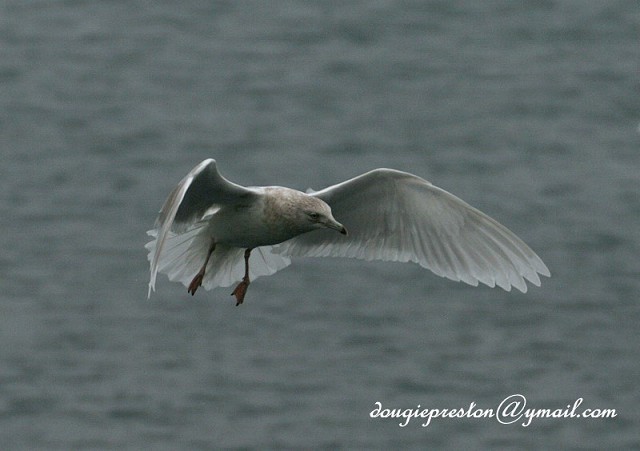
Kumlien's Gull, Lerwick, Mainland, Shetland (Photo: Dougie Preston)
Ring-billed Gulls remained at six sites in Ireland, including two at Sligo and three at Cuskinny Marsh (Co Cork). Four regular birds were in England, with new birds briefly at Pottington (Devon) on 8th and Staines Reservoir (Surrey) on 9th. In Scotland, adults were on Loch Ryan (Dumfries & Galloway) on 8th and at Dingwall (Highland) on 9th. The latter is possibly the returning bird that has recently developed a spring migration pattern, first seen in January 2004.
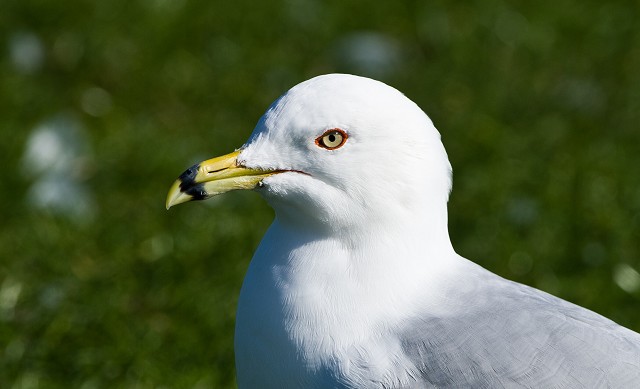
Ring-billed Gull, Gosport, Hampshire (Photo: John Stanton)
Other big gulls of interest included a possible second-winter American Herring Gull on the Hayle Estuary (Cornwall) on 8th and not one, but two, Baltic Gulls; a possible near-adult was at Lackford Lakes (Suffolk) on 6th–9th and a report of an adult, at Dungeness (Kent) briefly on 9th. The adult Bonaparte's Gull was at Lligwy Bay (Anglesey) to at least 7th and a first-winter was on the Ythan Estuary (Aberdeenshire) on 6th. This is the first 'non-adult' in the region, following records of presumed returning adults at Peterhead and Ugie Estuary in 2005–08.

Baltic Gull, Lackford Lakes SWT, Suffolk (Photo: Mick Southcott)
A couple of very long-staying birds were the Forster's Tern, reported again at Doorus (Co Galway) on 6th, and the male Snowy Owl at Mangurstadh, Lewis (Outer Hebrides) again on 4th.
Number of winter Shore Larks continued to dwindle, with 11 at Dingle Marshes (Suffolk), 10 at Cley Marshes (Norfolk), seven in Holkham Bay (Norfolk), three at Reculver (Kent) and the singleton remaining at Nosterfield Quarry (North Yorkshire) to 6th.

Shore Lark, Dunwich Pools, Suffolk (Photo: Ian Clarke)
In contrast to these lingering winter visitors, there were small numbers of a few migrants, including the first Hoopoe of the spring, in gardens near Hayle (Cornwall) on 7th. Sand Martins were reported from five counties, as far north as Lackford Lakes (Suffolk) and Paxton Pits (Cambridgeshire), with three at Port Meadow (Oxfordshire) on 9th. The same day also saw single Swallows at Wentwood Forest (Gwent) and Pwllheli (Gwynedd) and two in Clevedon (Somerset). There were also plenty of Wheatears, as far north as Berry Hill Fields (Staffordshire). Also of note was a Dartford Warbler at World's End (Clwyd) from 2nd–7th.
Waxwing numbers continued to thin out, but they were still quite concentrated along the centre of the UK. Peak counts included 200 in Iver (Buckinghamshire), 160 in Biggleswade (Bedfordshire), 150 in Sunbury (Surrey), 150 in Abingdon (Oxfordshire) and 135 in Norwich (Norfolk). There were no Welsh records, but in Northern Ireland up to 50 were in Carnmoney (Co Antrim). The furthest southwest was one at Indian Queens (Cornwall) on 4th and the furthest north were two in Aberdeen on 3rd.

Waxwing, Norwich, Norfolk (Photo: Andy Thompson)
Perhaps the first of many for 2011, there was an unconfirmed report of a Red-flanked Bluetail at Arundel (West Sussex) on 4th. After another short absence, the Penduline Tit was back at Dungeness (Kent), reported on 8th. Again, Great Grey Shrikes were clustered around Dorset, Hampshire, Surrey and south Wales, with perhaps as many as 34 birds still present.

Great Grey Shrike, Aylesbeare Common RSPB, Devon (Photo: Karen Woolley)
The first-winter Rose-coloured Starling remained in Penzance (Cornwall) all week. At Rainton Meadows (Durham) just one Coues' Arctic Redpoll remained (to 5th), though one found with a small group of redpolls in Bedford from 7th–9th was popular. There was also a probable in Richmond Park (London) on 4th–6th.

Coues' Arctic Redpoll, Bedford, Bedfordshire (Photo: Steve Blain)
Lapland Buntings, now moulting into fine summer plumage, were present at several coastal sites, with peak counts of over 150 at Port Isaac (Cornwall) and 56 at Weybourne (Norfolk). Signs of a return movement northward might have been the single northern birds at South Shields (Durham) and Point of Ayre (Isle of Man) on 8th. There were also more reports of inland Snow Buntings, with singletons at Cold Edge Dams (West Yorkshire) on 3rd and Carsington Water (Derbyshire) on 8th.

Lapland Bunting, Abberton Reservoir, Essex (Photo: Sean Nixon)
The four Northern Long-tailed Tits remained at Dymchurch (Kent) to at least 8th, with a further bird in a garden in Liverpool on 5th. The Central Asian Lesser Whitethroat also remained at Drogheda (Co Louth) to at least 6th, and there were reports of Nordic Jackdaws from Bothal Pond (Northumberland) and Dunfermline (Fife).

Nordic Jackdaw, Bothal Pond, Northumberland (Photo: Alan Tilmouth)
Photo of the Week: 3rd–9th March 2011

Barn Owl, Gayton, Norfolk (Photo: Stephen Durrant)
Two years ago this week, our Photo of the Week featured a Kestrel trying to steal prey from a Barn Owl as it hunted in Worcestershire. This behaviour is apparently widespread, but more often witnessed than photographed. In fact, we hadn't received any further photos showing this form of kleptoparasitism until we received an image from Stephen Durrant this week showing a similar scene taking place in Norfolk. Stephen did an excellent job of capturing the high-speed action as the Barn Owl plunged earthward with the Kestrel right on its tail. Good lighting and composition, plus a natural backdrop, make for a striking image.
Other notable photos

Western Reef-egret, Gambia (Photo: Dave Williams)

Sparrowhawk, undisclosed site, Powys (Photo: Steve Wilce)
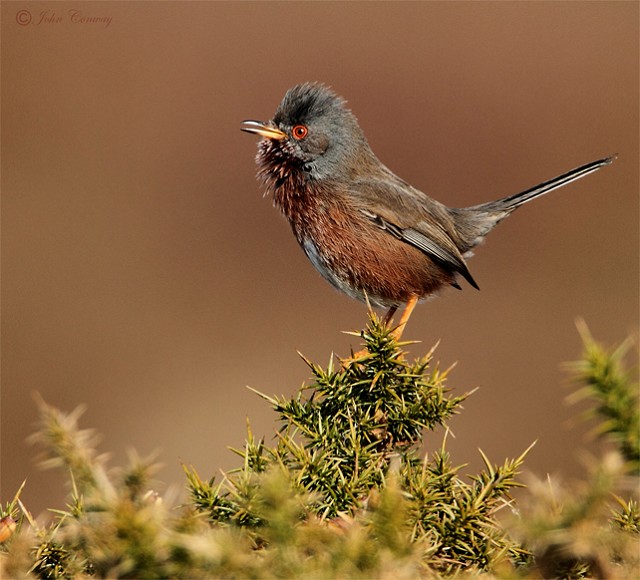
Dartford Warbler, World's End, Clwyd (Photo: John Conway)

Blue Tit, Spital, Cheshire (Photo: Steve Round)

Crested Tit, Grantown-on-Spey, Highland (Photo: Dean Eades)

Wren, Wigan, Greater Manchester (Photo: David Cookson)

Steller's Sea-Eagle, Japan (Photo: Karen Hargreave)

Nuthatch, Salcey Forest, Northamptonshire (Photo: Ben the Plumber)

Great Spotted Woodpecker, Alcester, Warwickshire (Photo: Mr Clive Daelman)

Pallid Swift, Morocco (Photo: Daniel Trim)

Common Kestrel, Draycote Water, Warwickshire (Photo: Dave Hutton)

Mistle Thrush, Haigh CP, Greater Manchester (Photo: Roy)

Twite, Dunwich Pools, Suffolk (Photo: Mick Southcott)

Great Spotted Cuckoo, Spain (Photo: Steve Fletcher)

Lesser Redpoll, Llandrindod Wells, Powys (Photo: Kev Joynes)

Dipper, undisclosed site, Devon (Photo: Charlie Fleming)

Alpine Accentor, Hungary (Photo: Eduardo Balogh)

Chough, undisclosed site, Cork (Photo: Ronan McLaughlin)
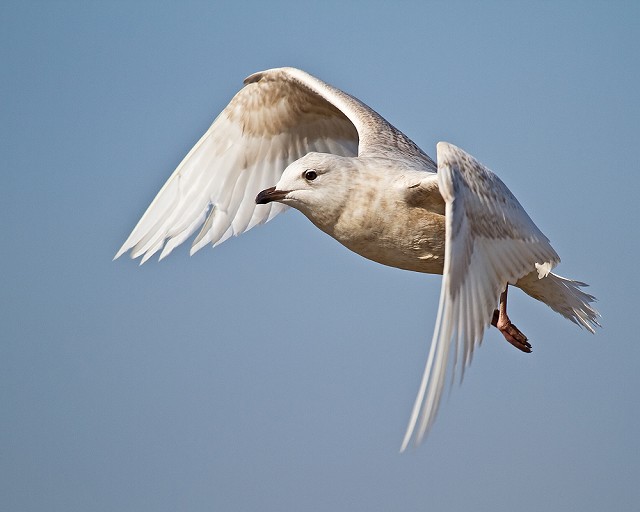
Iceland Gull, Lowestoft, Suffolk (Photo: Garth Peacock)

Goldcrest, France (Photo: Artur)

